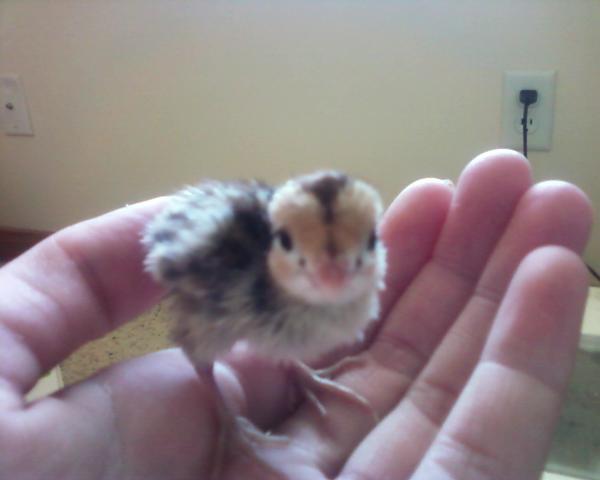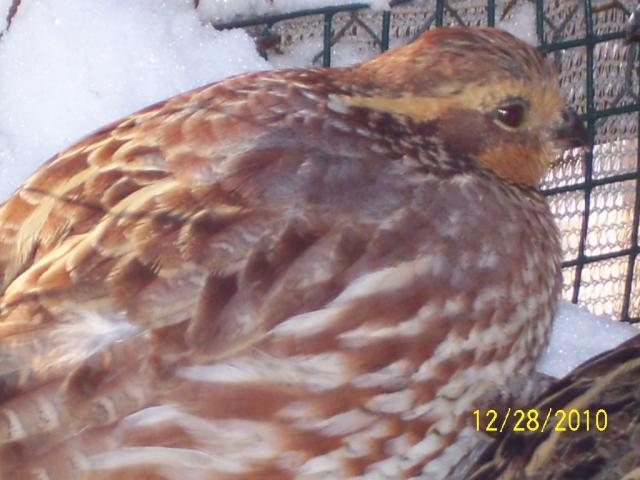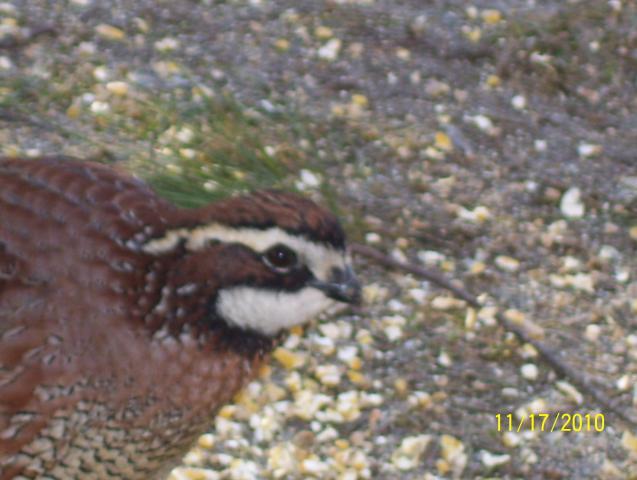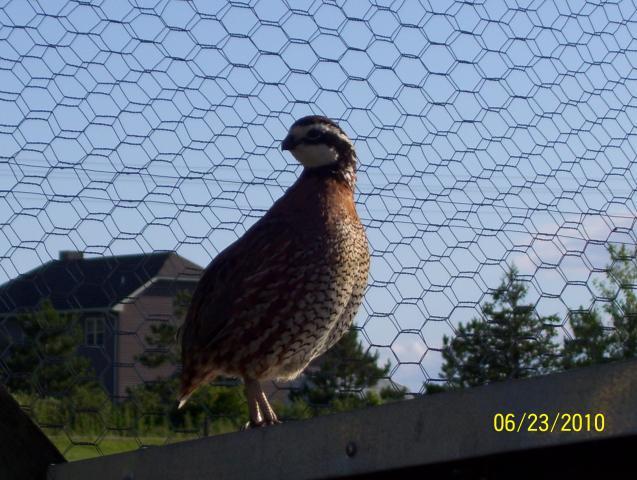-Raising Bobwhite Quail-
Bobwhites are a popular breed for dog training and hunting. Bobwhites are easy to keep and raise. Bobwhites were my first birds ever, and I never had any problem with aggresion. They are verly fun little birds to have around, the male's call is very nice to hear. Bobwhites provided food for settlers. They were also used for meat, eggs, and hunting. Bobwhite quail are and were famous for their flight action for hunting! The settlers used them for that reason, and the meat.
Hatching and Brooding Bobwhite Quail
-Hatching-
Bobwhite Quail are easy to hatch. I incubate my Bobwhite eggs in a 1266 Sportsman Cabinet incubator. Hovabator, Little Giant, and Brinsea are some more good ones, but I would be careful with LG's (Little Giants), I know a few people who don't have very good luck with them, I have tried it and it wasn't the best. Hovabators are probably your best bet. Bobwhite Quail take 23-26 days to hatch, with 26 days being the longest. Their temperature needs to be at 99.5-100F. When I incubate them I have our incubator at 100F, I keep turning them through their whole hatch time. I don't stop turning them at the 20th day. If the chicks don't hatch on their due date, give them 3 extra days to hatch.
-Brooding-
Bobwhite chicks are tough, although not like their parents. I used to use a plastic rubbermaid tub, but it was boiling hot in there for them. Ours looks like this , but with stands below it. It works really well. I keep the temp at 99 in the brooder for the first five days, then I lower it to 96F in their second week and so on. They are feed a 24% Gamebird Starter, I feed them Manna Pro Gamebird/Showbird Starter feed. It works very well. DO NOT feed them medicated food. Try to keep the food at 22% or higher protein. For my chicks I use a Quail Waterer, to prevent them from drowning. If you cannot get those or you don't want to, you can use a chicken chick waterer, but make sure to but marbles in there so they can't drown. Once they are 7 weeks old I move them outside, in to a pen with no birds in it. If the temperature is under 50F I switch on their heat lamp, inside their house/shelter. I feed them the same way, but I add Manna Pro Poultry Conditioner if I plan on showing them. When they have been kept outside for 2 weeks, I switch them over to Sprout Meat Maker which has 22% protein.
Housing and Breeding Bobwhite Quail
-Housing-
I like to keep my bobs on ground, which means they get a bigger area to run and fly around. Our main Bobwhite pen in 12 x 14' in in length. When our Bobwhites are on ground we have pea rock on they groud, for a natural setting, and they can dig around in the rocks. They don't NEED a shelter in their pen, but I like to put one in each pen for if we have a big storm or to lay their eggs in. Many people keep their birds on wire, but I don't have good luck with that at all. They get bloody feet all the time, and break their necks. I hate keeping birds on wire because of that (maybe its because our wire pen is evil lol). Our wire pen is 3' high and 12' long. We have 1/4 in wire on the bottom, but the wire should be a litte bit bigger so the droppings can fall through, but not too big so raccoons can't get them. During the Winter, birds that are not kept indoors such as a barn, should be grouped together so they can form natural coveys for warmth.
-Breeding-
Breeding is relatively easy with Bobwhites. They should be in a ratio of 1 male to 3 hens, which is what I like to do. I also breed them in pairs and trios occationaly. Colonies consist of 2-3 males with 9-10 hens. I sometimes breed them in colonies but not very often. Don't put to many males together to prevent fighting. Feed them 24-30% protein Gamebird Breeder feed in the breeding season. Bobwhite hens begin laying in mid April and may lay all summer long. The eggs are normally pure white. The female can produce a great amount of eggs! They will lay all year round with light for 14 hours a day.
Thanks for reading!
Bobwhites are a popular breed for dog training and hunting. Bobwhites are easy to keep and raise. Bobwhites were my first birds ever, and I never had any problem with aggresion. They are verly fun little birds to have around, the male's call is very nice to hear. Bobwhites provided food for settlers. They were also used for meat, eggs, and hunting. Bobwhite quail are and were famous for their flight action for hunting! The settlers used them for that reason, and the meat.
Hatching and Brooding Bobwhite Quail
-Hatching-
Bobwhite Quail are easy to hatch. I incubate my Bobwhite eggs in a 1266 Sportsman Cabinet incubator. Hovabator, Little Giant, and Brinsea are some more good ones, but I would be careful with LG's (Little Giants), I know a few people who don't have very good luck with them, I have tried it and it wasn't the best. Hovabators are probably your best bet. Bobwhite Quail take 23-26 days to hatch, with 26 days being the longest. Their temperature needs to be at 99.5-100F. When I incubate them I have our incubator at 100F, I keep turning them through their whole hatch time. I don't stop turning them at the 20th day. If the chicks don't hatch on their due date, give them 3 extra days to hatch.
-Brooding-
Bobwhite chicks are tough, although not like their parents. I used to use a plastic rubbermaid tub, but it was boiling hot in there for them. Ours looks like this , but with stands below it. It works really well. I keep the temp at 99 in the brooder for the first five days, then I lower it to 96F in their second week and so on. They are feed a 24% Gamebird Starter, I feed them Manna Pro Gamebird/Showbird Starter feed. It works very well. DO NOT feed them medicated food. Try to keep the food at 22% or higher protein. For my chicks I use a Quail Waterer, to prevent them from drowning. If you cannot get those or you don't want to, you can use a chicken chick waterer, but make sure to but marbles in there so they can't drown. Once they are 7 weeks old I move them outside, in to a pen with no birds in it. If the temperature is under 50F I switch on their heat lamp, inside their house/shelter. I feed them the same way, but I add Manna Pro Poultry Conditioner if I plan on showing them. When they have been kept outside for 2 weeks, I switch them over to Sprout Meat Maker which has 22% protein.
Housing and Breeding Bobwhite Quail
-Housing-
I like to keep my bobs on ground, which means they get a bigger area to run and fly around. Our main Bobwhite pen in 12 x 14' in in length. When our Bobwhites are on ground we have pea rock on they groud, for a natural setting, and they can dig around in the rocks. They don't NEED a shelter in their pen, but I like to put one in each pen for if we have a big storm or to lay their eggs in. Many people keep their birds on wire, but I don't have good luck with that at all. They get bloody feet all the time, and break their necks. I hate keeping birds on wire because of that (maybe its because our wire pen is evil lol). Our wire pen is 3' high and 12' long. We have 1/4 in wire on the bottom, but the wire should be a litte bit bigger so the droppings can fall through, but not too big so raccoons can't get them. During the Winter, birds that are not kept indoors such as a barn, should be grouped together so they can form natural coveys for warmth.
-Breeding-
Breeding is relatively easy with Bobwhites. They should be in a ratio of 1 male to 3 hens, which is what I like to do. I also breed them in pairs and trios occationaly. Colonies consist of 2-3 males with 9-10 hens. I sometimes breed them in colonies but not very often. Don't put to many males together to prevent fighting. Feed them 24-30% protein Gamebird Breeder feed in the breeding season. Bobwhite hens begin laying in mid April and may lay all summer long. The eggs are normally pure white. The female can produce a great amount of eggs! They will lay all year round with light for 14 hours a day.
Thanks for reading!
Last edited:








